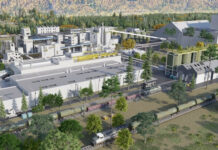By Jack Rogers
From the July/August 2012 issue
For as long as most people can remember, Ontario has been Canada’s mining and manufacturing center, with a heavy emphasis on exports.
But as the continued strength of the Canadian dollar has created a trade deficit, Ontario is aggressively moving to diversify its economic base with new high-growth sectors like information communications technology (ICT) alternative energy and digital media.
Ontario has become a North American hot spot for ICT. We offer everything leading ICT companies need to succeed: a smart, skilled workforce, outstanding researchers and research facilities, exceptional R&D tax credits, the lowest business costs in the G7 and an enviable quality of life that is needed to attract top talent. The provincial government is making ICT research and commercialization a priority.
Maryland-based Ciena is investing $900 million to expand its R&D operations in Ontario. Advanced Micro Devices (AMD), headquartered in California, is investing $376 million+ in the province to accelerate the development of a revolutionary new family of processors, while French gaming giant Ubisoft is spending more than $500 million to open a new studio here.
Ontario’s Green Energy and Green Economy Act (GEA), passed in 2009, places a priority on establishing Ontario as the North American leader in producing and using clean and renewable sources of energy including wind, water, solar, biomass and biogas power.
Ontario also is a center for research and development and manufacture of bio-based technologies, processes and products. Companies like LANXESS, The Woodbridge Group, Stemergy, Lorama, Iogen and Anaergia are here, taking biomass and turning it into green energy, chemicals and materials for rapidly expanding global markets.
And Ontario is attracting more international companies all the time. The latest is Plymouth, Minnesota-based BioAmber, which is building its first North American renewable chemical plant in Sarnia.
The demand for alternative energy in North America is growing—and Ontario is in a prime position to meet that demand, given its establishment of North America’s first comprehensive Feed-In Tariff Program for energy generated from renewable sources.
This combined with Ontario’s strategic location in North America, long-term government support for alternative energy generation and advanced and diverse manufacturing capabilities, position Ontario as a preferred location for manufacturers of sustainable, alternative energy technologies and related components, service providers and project developers.
The province’s Green Energy Act, introduced in May 2009, and the Water Opportunities and Water Conservation Act, introduced in November 2010, provide investors, communities and companies the tools they need to create a cleaner, greener future.
Brampton: A Center of Growth
The City of Brampton, located in the western GTA (Greater Toronto Area) is the 9th largest city in Canada and the 3rd largest in the GTA. With a population of 523,911, Brampton is the 2nd fastest growing city in Canada, averaging growth of 4.2% per year (or approximately 18,000 new residents per year) made up of more than 175 distinct ethnic backgrounds speaking more than 70 different languages. The Province of Ontario has designated Brampton as an urban growth area and by 2031, the City’s population is expected to grow to 725,000.
Brampton has positioned itself as a global economic contender. Home to the largest intermodal railway terminal in Canada and with immediate access to an extensive network of trans-continental highways, it is also located just north of Canada’s largest international airport, Toronto Pearson International serving 34 million passengers annually.
Brampton’s diversified economy is represented by more than 8.000 businesses, 153,000 workers and has an economic base comprised of 72% services-producing sector and 28% goods producing sector.
- A $650 million (CDN) municipal organization. Achieved a ‘AAA’ credit rating designated by Standard & Poor’s.
- Voted in Top 10 Cities in North America for Foreign Direct Investment—Best Infrastructure Large City 2011/12
- Designated as a World Health Organization International Safe Community
- Over 6,000 acres of vacant employment lands available for development and revitalization
The City’s major business sectors include Manufacturing, Retail and Wholesale Trade, Food and Beverage, Information and Communication Technology, and Life Sciences. The manufacturing industry remains the City’s largest employer.
Businesses continue to show significant confidence in Brampton’s economy. In 2011 national statistics elevated Brampton to the 6th most active construction market in Canada, ahead of Vancouver, Winnipeg, Quebec City and Hamilton. Employment rose by 31% on the strength of 242 new businesses.
In 2012, Air Canada announced the construction of their Systems Operations Control Centre (SOC) which will open in 2014 and essentially be the new “nerve centre” of the airline. The Air Canada facility will translate into 500 knowledge-based jobs in addition to millions of dollars in capital investment.

In 2011, Canadian Blood Services opened a state-of-the art blood processing and distribution centre in Brampton. The centre, as part of an $83 million capital investment by Canadian Blood Services, serves about 100 hospitals in southern and central Ontario. Their reason to choose Brampton was location, and at the centre of Canada’s major transportation corridors— and close to Toronto Pearson International Airport. Blood products can be shipped easily to and from other parts of the country.
Headquartered in Brampton, Gamma-Dynacare is Canada’s largest provider of laboratory services and have just completed a multimillion dollar expansion to their head office and laboratory facility. With 700 employees, Gamma-Dynacare is Brampton’s seventh largest employer.
Overall, Brampton is a well-planned city with a rich history and cultural heritage, offering an unparalleled quality of life with access to excellent health care, education, transit, recreation and arts and cultural opportunities.
Port Colborne: Gateway to Ontario
The City of Port Colborne, Ontario, is located in the Niagara region of the province, where the Welland Canal opens up into Lake Erie. The canal is a key part of the St. Lawrence Seaway System. “Any vessel that passes from the Atlantic Ocean through Lake Ontario and into the upper Great Lakes needs to pass right through our community,” says Stephen Thompson, general manager, Port Colborne Economic Development Tourism Corp.
The port is managed by the St. Lawrence Seaway Management Corp., and the City of Port Colborne manages other assets. The port provides several strategic advantages. It is within 20 minutes of the border crossing at Buffalo, N.Y., and 30 minutes from the border crossing at Niagara Falls, N.Y. What’s more, Toronto is located just an hour away from the city.
The port offers a niche in the movement of bulk goods such as aggregates and grains. A public grain elevator acts as a storage facility and intermediary location to move bulk product from smaller ships to larger ships.
Thompson says Casco, Inc., a biotech company that provides product derived from corn to food companies and others, has its own private dock. It can bring ships into the canal during the three month shut down, from January to mid to late March, “which creates other unique opportunities for our port and our community,” he says.
Ships come in during the winter months for routine maintenance, ship repair and ship building activities. “We are able to support these activities because of our strong manufacturing base, particularly in fabricated metals,” Thompson says.

The port also features a short-line rail connection, which continues to expand, and is run by the city. A private rail operator, located adjacent to the community, offers rail service into the port and a number of its private facilities. This rail line connects directly to both the Canadian National and the Canadian Pacific main lines.
Thompson notes ongoing activities include building and enhancing warehouse and distribution space at the port. A couple of facilities are nearing completion, which range in size from 50,000 to 100,000 square feet. The facilities can be divided, if needed. “We are also working with the St. Lawrence Seaway Management Corp. to bring more land to market along the Welland Canal,” Thompson says.
The city of Port Colborne is a key multi-logistics hub in southern Ontario with highway, rail and port infrastructure. On Niagara’s South Coast, Port Colborne is just minutes away from one of the principal border crossings between Canada and the United States. Port Colborne is a location of choice for the transportation and logistics industry; the city is where the the Welland Canal connects to Lake Erie, and is serviced by two of the largest railway networks in North America.
Port Colborne is part of Ontario’s new Gateway Economic Centre and includes an area designated as Niagara’s Economic Growth Zone. Projects are already well underway to expand transportation links and expedite the movement of goods.
Due to the Gateway Economic Centre’s proximity to the United States, import/export industries, distribution centres, and logistics hubs are choosing this strategic location. Canada’s Foreign Trade Zone flexibilities are available in Port Colborne creating an opportunity for facilities located in the Gateway Economic Centre to import and reprocess goods with reduced or eliminated tariffs, as well as programs to offset sales taxes.
Port Colborne is linked to a sophisticated highway network, with three main highways providing irect access to Port Colborne. Several highways are currently being expanded, and a new highway is being developed which creates a second connection from Port Colborne to the US border.
In addition, the Port Colborne Harbour Railway serves many industrial sites in Port Colborne, connecting its clients to CP and CN mainlines adjacent to the community.
Three international airports and four regional airports are within a two-hour drive of Port Colborne. Located within a day’s drive half of North America’s purchasing power, Port Colborne is perfectly positioned to serve Canadian and U.S. markets.
















![[VIDEO] Get More for Your Business in Ardmore. Oklahoma](https://businessfacilities.com/wp-content/uploads/2024/02/maxresdefault-324x160.jpg)
